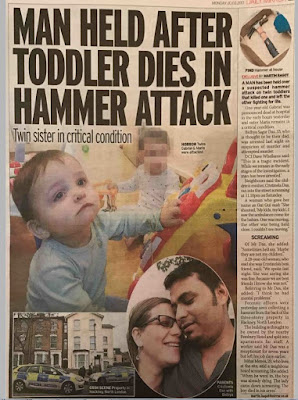Wednesday, 29 November 2017
Analysing reports
THE TIMES:
Headline lexis: Man held after baby dies 'in attack on twins'. Giving the title 'man' , makes the murderer anonymous and mysterious. It also creates enigma and makes audiences want to know who this 'man' is. The verb 'die' sounds cold and intrusive, as it is explaining the murder of a child. Attack on twins gives the story a narrative and sounds like a title to a story. This gives a basic idea on what the advert is based on.
Selection of Images:
The only image used includes a low angle shot of police entering the crime scene.
DAILY MIRROR:
Headline lexis: Man held after toddler dies in hammer attack
Use of 'toddler' makes the victim sound even more vulnerable and innocent, giving the story more tragedy. 'Hammer attack' sounds violent, and the producer has jumped to conclusions on how the murder happened just to make the story more tragic.
Selection of Images: The use of an image where the victim looks upset creates more emotion and sensationalistic characteristics to the news report. An image where the potential murderer looks content makes audiences think that murderers can look like an average person, and you can never know who can capable of doing such a thing.
Layout: This news story is considerably larger in size in comparison to the times report, maybe because the story evokes emotion, tragedy and scandal which is more common of a tabloid newspaper.
In what ways can media products incorporate viewpoints and ideologies? (Talking only about these articles)
Media language can be used to incorporate viewpoints and ideologies. For example, in the Daily Mirror article, emotive language is used to describe the victim to enhance his vulnerability and innocence. This gives the story more tragedy, and consequently giving a viewpoint in which the children are in danger. This language creates ideologies based around the murderer. "Hammer attack" gives connotations of violence and makes the murderer sound more brutal as the murder weapon is mentioned.
Barthes codes are also used to create enigma in the headline. The unidentified suspect makes audiences suspicious and want to know more.
Subscribe to:
Post Comments (Atom)


No comments:
Post a Comment